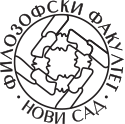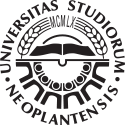15KSAP12 - Translation Tools and Technologies
| Course specification | ||||
|---|---|---|---|---|
| Course title | Translation Tools and Technologies | |||
| Acronym | 15KSAP12 | |||
| Study programme | Conference Interpreting and Translation | |||
| Module | ||||
| Type of study | second degree master academic studies | |||
| Lecturer (for classes) | ||||
| Lecturer/Associate (for practice) | ||||
| Lecturer/Associate (for OTC) | ||||
| ESPB | 3.0 | Status | ||
| Condition | none | Oblik uslovljenosti | ||
| The goal | Development of skills necessary to efficiently use and apply information technology in translation, from the basic level of text processing and translation-relevant spreadsheet calculation, through text digitization, management of digitized text resources and use of online resources for translation and terminology management, all the way to using a computer-aided translation and terminology management tool - SDL Trados Studio; upskilling students to be capable of obtaining the SDL-issued certificate for the relevant version of SDL Trados Studio. | |||
| The outcome | By the end of the course the students will have gained the ability to efficiently use information technology in translation: digitalization of texts, parallelization of texts and creation of translation memory, extraction of terminology from mono-lingual and multilingual texts in electronic form (online and offline), creation of a glossary in SDL Multiterm, creation of AutoSuggest dictionaries, translation memory administration, teamwork work on the translation project via the Internet, proofreading and correction within the SDL Trados Studio package. Also, by the end of the course, the students should be able to take and pass the SDL translation certification exam: SDL Trados Studio - Level 3 Certification and SDL MultiTerm Level Certification. | |||
| Contents | ||||
| Contents of lectures | A brief history of the development of programs for computer-aided translation and general principles of computer-aided translation work (segmentation, translation unit, etc.).A general overview of commercial and free software packages for computer-aided translation.Digitization of textual materials. Different file formats for storing text data. Creating a translation memory: techniques and methods of collecting representative texts, formatting and paralleling texts, compilation of a translation memory in SDL Trados Studio. Creating an AutoSuggest dictionary. Machine translation. Compilation of a termbase, the foundation of terminology extraction and compilation of bilingual glossaries in SDL Multiterm. Independent translation and team work through SDL server software packages or free online translation tools.Reviewing, checking and revising translation in the freelance/independent work mode and in team work. Coordinating the team and maintaining a translated database.Internet as a translation resource. | |||
| Contents of exercises | Practical application of theoretical knowledge by means of exercises and translation projects in the SDL Trados Studio. Practical demonstration of workflows in Star Transit, Atril DejaVu, Wordfast and OmegaT, as well as creating a team translation project using the Google Translator Toolkit. | |||
| Literature | ||||
| ||||
| Number of hours per week during the semester/trimester/year | ||||
| Lectures | Exercises | OTC | Study and Research | Other classes |
| 0 | 2 | |||
| Methods of teaching | frontal instruction and interactive teaching, independent student work | |||
| Knowledge score (maximum points 100) | ||||
| Pre obligations | Points | Final exam | Points | |
| Activites during lectures | 0 | Test paper | 70 | |
| Practical lessons | 0 | Oral examination | 0 | |
| Projects | 30 | |||
| Colloquia | 0 | |||
| Seminars | 0 | |||

